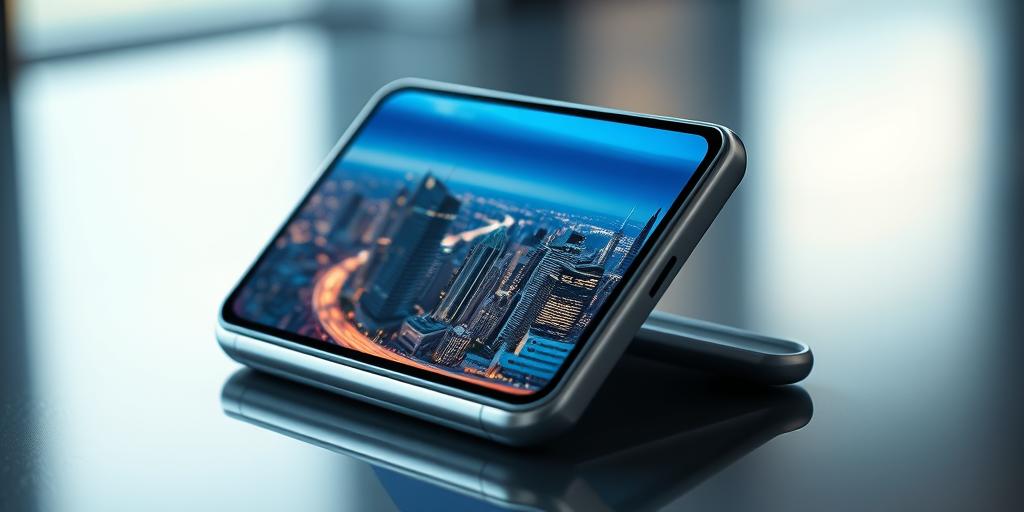The tech world is buzzing—no, not just buzzing, it’s downright fractured! The reason? Foldable phones. Are they the future of mobile technology, a revolutionary leap forward, or just an overpriced gimmick destined for the tech graveyard? The debate rages on, pitting enthusiasts against skeptics, and leaving many consumers utterly bewildered. Let’s dive into the heart of this divisive tech trend and uncover why foldable devices are causing such a stir.
The Allure of Foldable Phones: A New Era of Portability?
Foldable phones offer a compelling proposition: the convenience of a pocketable device combined with the expansive screen real estate of a tablet. Imagine effortlessly switching between one-handed texting and immersive video viewing—all on the same device! This transformative form factor promises a seamless blend of portability and functionality. Many consider this the ultimate marriage of compact design and high screen-to-body ratio, offering a user experience unlike anything seen before. The potential uses are vast, from enhanced multitasking to significantly improved media consumption. But this vision of a technological utopia comes with its caveats.
Addressing Common Concerns: Durability and Price
One of the most significant obstacles hindering widespread adoption is the concern over durability. While manufacturers have made significant strides in improving the structural integrity of foldable screens, the delicate nature of the hinge and the display itself remains a point of contention. The fear of accidental damage, leading to costly repairs, understandably makes many hesitant to take the plunge. This is also exacerbated by the often-prohibitive price tag attached to these devices, putting them out of reach for the average consumer. Are foldable phones really worth the investment, considering their fragility and high price point? The answer, as we will see, is nuanced.
Innovation and Beyond: The Tech Behind the Fold
The technology behind foldable phones is far more intricate than your average smartphone. The engineering marvel of seamlessly integrating a flexible display within a sturdy frame is a feat of innovation in itself. The sophisticated hinge mechanisms, the ultra-thin glass, and the specialized display technology all contribute to the complexity and cost. And the innovation doesn’t stop there; the software experience is meticulously designed to optimize the user interface for both folded and unfolded modes. Understanding these complexities helps to appreciate the impressive engineering and the considerable technological advancements that have gone into making these devices a reality. But even this technological marvel isn’t enough for all users.
The Critics’ Corner: Why the Foldable Frenzy Isn’t for Everyone
Despite the allure of larger screens and enhanced portability, many remain unconvinced. The high price point, as mentioned before, is a major deterrent. The perceived fragility, the potential for screen creases, and the limited app compatibility add to the skepticism. Critics often point to the still relatively short battery life as another significant drawback. Some argue that existing technology already provides many benefits of foldable devices, like external monitors, while avoiding some of the potential downsides.
The Verdict: Hype or Revolution?
So, what’s the verdict? Are foldable phones a revolutionary leap forward or a passing fad? The answer, as with most technological advancements, is complex and multifaceted. While they don’t offer a flawless experience just yet, foldable devices represent a significant step forward in mobile technology, showcasing remarkable innovation in display technology and engineering. However, the high price point, durability concerns, and some lingering limitations prevent them from being a universally accepted alternative to traditional smartphones. For now, they remain a niche product, appealing mostly to tech enthusiasts and those who prioritize large screen size and portability above all else.
The Future of Foldable Technology: What Lies Ahead?
As technology evolves, we can anticipate that the challenges surrounding foldable phones will be gradually addressed. Expect improvements in durability, screen technology, and battery life. The reduction in manufacturing costs will also make them more accessible to a wider consumer base. Ultimately, the continued development and adoption of foldable technology will largely depend on addressing the concerns of durability, price, and app compatibility. The future of foldable devices depends on overcoming these key challenges, and then perhaps it will live up to its full potential.
Investing in a foldable phone is a gamble; it’s betting on a future that may or may not fully deliver on its promises. But one thing is certain, foldable phones are here to stay, and they’re only going to get better. So, are you ready to join the fold? Or will you remain a steadfast supporter of the traditional smartphone?
The decision is yours. But the future is folding.




